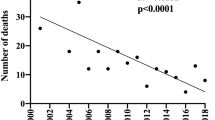Abstract
Objective
To examine whether CO poisoning induces a significant increase in plasma lactate concentration.
Design and setting
Prospective observational clinical study in the emergency department and intensive care unit in a university-affiliated teaching hospital.
Patients
146 pure CO poisonings resulting from dysfunction of gas cookers or water heaters.
Measurements and results
Patients were classified into four neurological impairment groups: 37% were severely, 8% moderately, and 45% mildly intoxicated, while 1% were asymptomatic. We found only very mild increases in plasma lactate concentration (median 2.30 mmol/l) which, however, was significantly correlated with the severity of neurological impairment and blood CO concentration (1.41 mmol/l, Spearman's test r=0.3).
Conclusions
Plasma lactate is mildly elevated in pure CO-exposed patients. This mild increase and the extensive overlap between the groups of neurological impairment severity do not suggest the usefulness of systematic plasma lactate measurement in pure CO poisoning.

Similar content being viewed by others
References
Ernst A, Zibrak JD (1998) Carbon monoxide poisoning. N Engl J Med 339:1603–1608
Baud FJ, Barriot P, Toffis V, Riou B, Vicaut E, Lecarpentier Y, Bourdon R, Astier A, Bismuth C (1991) Elevated blood cyanide concentrations in victims of smoke inhalation. N Engl J Med 325:1761–1766
Baud FJ, Borron SW, Mégarbane B, Trout H, Lapostolle F, Vicaut E, Debray M, Bismuth C (2002) Value of lactic acidosis in the assessment of the severity of acute cyanide poisoning. Crit Care Med 30:2044–2050
Messier LD, Myers RAM (1991) A neuropsychological screening battery for emergency assessment of carbon-monoxide-poisoned patients. J Clin Psychol 47:675–683
Persson HE, Sjöberg GK, Haines JA, Pronczuk de Garbino J (1998) Poisoning Severity Score. Grading of acute poisoning. J Toxicol Clin Toxicol 36:205–213
Ilano AL, Raffin TA (1990) Management of carbon monoxide poisoning. Chest 97:165–169
Sokal JA, Kralkowska E (1989) The relationship between exposure duration, carboxyhemoglobin, blood glucose, pyruvate and lactate and the severity of intoxication in 39 cases of acute carbon monoxide poisoning in man. Arch Toxicol 57:196–199
Sokal JA (1985) The effect of exposure duration on the blood level of glucose pyruvate and lactate in acute carbon monoxide intoxication in man. J Appl Toxicol 5:395–397
Buehler JH, Berns AS, Webster JR, Addington WW, Cugell DW (1975) Lactic acidosis from carboxyhemoglobinemia after smoke inhalation. Ann Intern Med 82:803–805
Langston P, Gorman D, Runciman W, Upton R (1996) The effect of carbon monoxide on oxygen metabolism in the brains of awake sheep. Toxicology 114:223–232
Myers RAM, Britten JS (1989) Are arterial blood gases of value in treatment decisions for carbon monoxide poisoning? Crit Care Med 17:139–142
Lebby TI, Zalenski R, Hryhorczuk DO, Leikin JB (1989) The usefulness of the arterial blood gas in pure carbon monoxide poisoning. Vet Hum Toxicol 31:138–140
Levasseur L, Galliot-Guilley M, Richter F, Scherrmann JM, Baud FJ (1996) Effects of mode of inhalation of carbon monoxide and of normobaric oxygen administration on carbon monoxide elimination from the blood. Hum Exp Toxicol 15:898–903
Weaver LK, Howe S, Hopkins R, Chan KJ (2000) Carboxyhemoglobin half-life in carbon monoxide-poisoned patients treated with 100% oxygen at atmospheric pressure. Chest 117:801–808
Shimazu T (2001) Half-life of blood carboxyhemoglobin. Chest 119:661–663
Weaver LK, Hopkins RO, Chan KJ, Churchill S, Elliott CG, Clemmer TP, Orme JF, Thomas FO, Morris AH (2002) Hyperbaric oxygen for acute carbon monoxide poisoning. N Engl J Med 347:1057–1067
Slomovitz BM, Lavery RF, Tortella BJ, Siegel JH, Bachl BL, Ciccone A (1998) Validation of a hand-held lactate device in determination of blood lactate in critically injured patients. Crit Care Med 26:1523–1528
Author information
Authors and Affiliations
Corresponding author
Rights and permissions
About this article
Cite this article
Benaissa, M.L., Mégarbane, B., Borron, S.W. et al. Is elevated plasma lactate a useful marker in the evaluation of pure carbon monoxide poisoning?. Intensive Care Med 29, 1372–1375 (2003). https://doi.org/10.1007/s00134-003-1866-0
Received:
Accepted:
Published:
Issue Date:
DOI: https://doi.org/10.1007/s00134-003-1866-0




